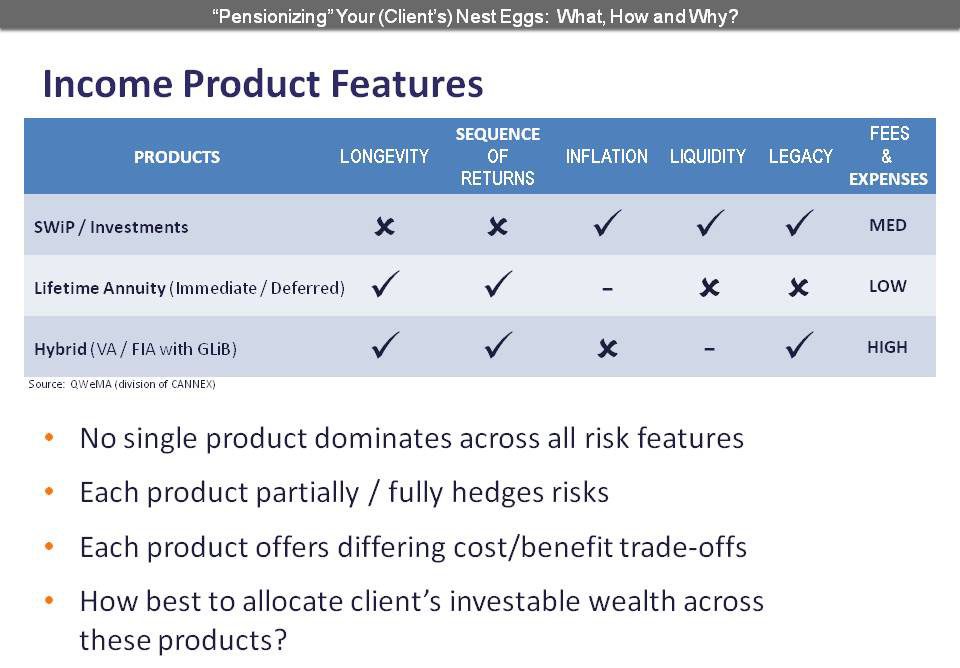
Faisal Habib, PE, MBA, FRM – Retirement Income and Investments Analysis Expert
Editor’s note: For 25 years, the 4% withdrawal rule has reigned supreme in the financial planning community as the single solution for the highest probability of creating sustainable income from a retirement portfolio. I must confess that I was part of that crowd, until I saw a paper in 2002 that demonstrated even better results when 25% of a portfolio was annuitized. Understanding and designing portfolio asset allocation is a key part of the Chartered Financial Analyst (CFA) training, so as I dug deeper, I discovered that annuitized income has strong diversification benefits for retirement portfolios. For years we’ve been taught all the negative characteristics of annuities as standalone products, but when paired appropriately with equities in well-designed portfolios, a client’s investing and income risk is decidedly better managed.
The Great Recession in 2008 significantly reduced the value of financial portfolios of many clients who had to recalibrate their retirement expectations and adjust their standard of living. At the same time, there were clients who (while their portfolios did take a hit) did not have to make significant adjustments. So what if you could identify ahead of time the clients and their portfolios that are exposed to extreme downside risk?
This article is an adaptation of the live webinar delivered by Faisal Habib in 2016. His comments have been edited for clarity and length.
You can read the summary article here as part of the July 2016 Retirement InSight and Trends Newsletter, worth 1.0 CE when read in its entirety (after passing the online quiz.)
By Faisal Habib, PE, MBA, FRM, President of QWeMA (pronounced KWEE-MA), a division of CANNEX Financial Exchanges Limited
Review of Key Retirement Risks
Why do we want to talk about retirement risks and management of these risks? The trend has been to move away from DB plans to what is known as defined contribution, or DC, plans. While the control of assets allocation has moved over to the individual, so have the risks that are unique in retirement.
So, let me start out with this very simple question. How much do I need at age 65 to generate $1,000 per month during retirement? One approach, the present value of annuity formula, calculates the present value of $1 of periodic payment. I can calculate this once I have the inputs, and then multiply by my payment that I’m seeking, which is $1,000, to obtain the answer. With this formula, I need two pieces of information: the rate of return and the time spent in retirement. What number should I use for the 65-year-old male? Is survival to age 80 appropriate? Six out of 10 65-year-old males will make it to age 80. Shall I use something in between, say, 80 and 85 because somewhere in between is the halfway point?
Here’s another slide that shows the whole probability distribution for a 65-year-old male, and I have marked the average years, which is approximately 20 years, along with the variability around that average. It is 20 years plus or minus 9 years. That’s a big variance. In this case, 9 out of 20 means 45%.
Let’s turn our focus to the rate of return. What’s an appropriate rate of return to use? We are all well aware that earning any rate consistently year over year doesn’t happen unless, of course, you’re simply parking the funds in a long-term CD; there is variance around the rate of return as well. For 30 years at 8%, I would need something around $136,283; that would get me $1,000 a month. Or if I put the money under the mattress at 0% for 30 years, I need $360,000.
The appropriate method is to use the present value formula that we discussed earlier and account for the uncertainties that is similar to the way of insurance companies do. In other words, use the actuarial form of the formula.
Today, the average of the premiums that an insurance company would charge for a $1,000-a-month payment for life for a 60-year-old male is approximately $190,490. Purchasing one of these single-premium income annuities would completely hedge longevity risk, which is the risk of running out of funds while you’re still alive. However, what does a $1,000 payment buy you at 2% average annual inflation? In 20 years, the value of the $1,000 dollar will decline by a third.
Say I have a triangle with three sequences of returns, or three types of returns. I start out with earning 17%, followed by 10%, then followed by -8%. Now let’s reverse the sequence, where I get the -8% return first, followed by 10%, and then followed by 17%. The average of these three returns in each scenario is exactly the same. It is 6%, and the standard deviation, or the variability around this average return, is 11%. In both of these worlds, I end up with the same value, or $1.18.
If we add a withdrawal of $0.05 every period, after returns of 17%, 10% and -8%, I’m left with $1.04. I do the same exercise, with returns in the reverse sequence, I’m left with $1.01.
What if I change my withdrawal rate again at the end of every period to $0.10 from my $1 portfolio with earning 17%, followed by 10%, followed by -8%? I’m left with $0.89. With the reverse sequence of returns, and I’m left with only $0.84. This is what we mean by the sequence-of-returns risk, that it creeps up when you’re making withdrawals from your portfolio.
If you were to repeat this exercise again and again, you could see when the portfolio runs out of money. If I realize the good sequence where negative returns are experienced at the end, and my portfolio lasts for 28 years. In the reverse sequence my portfolio only lasts for 20 years.
Applying this to real life, if a client retired at the beginning of 2008 with $100 and a 5% annual withdrawal, in five years he would be left with something like $65 or $67, after adjusting 2% for COLA. On the other hand, if that same client that started in 2009, in five years’ time, they would have $162 remaining in their portfolio. Now, why is that the case? In the fall of 2008, we had a severe market downturn, and in the beginning of 2009, we had that wonderful market recovery.
To recap, longevity risk is the risk of outliving one’s financial assets. Retirees are living longer due to improvements in medical technology, nutrition, disease control, public health, and environment. Inflation risk is the notion of purchasing power. As a matter of fact, retirees face a higher inflation rate given that the basket of goods that they consume is so much different from what you and I would be consuming. And then, the sequence-of-returns risk is the risk of realizing the significant series of poor returns early on in retirement. And it’s important to address and manage these risks since retirees do not get to choose their retirement date based on what sequence will materialize in the future.
How to Use Product Allocation to Manage Retirement Risks
So, looking at what kinds of products we have available to us, we can broadly look at the investments category and see what kinds of benefits or qualities they possess. Our traditional investments do not provide us with a longevity hedge or a sequence-or-returns hedge, but they do a good job on inflation, liquidity, and legacy. They do a good job on inflation because market returns do tend to be higher than inflation in the long run. They provide me with access to immediate liquidity. I can withdraw my funds at any moment in time, and they also contribute toward building a legacy.
There is another product category called the lifetime annuity, either immediate or deferred income annuity, and it provides a very good longevity hedge and a sequence-of-returns hedge because, regardless of what happens in the market, once I have made that premium payment to the insurance company, I keep receiving my monthly payment for as long as I’m alive. But in terms of liquidity or legacy, they do a poor job. I cannot tap into that premium that I have paid the insurance company, and it does not contribute toward building my legacy.
Then, there is a hybrid class of products. These are variable annuities or fixed-index annuities with a guaranteed living benefit (GLB) contract. I like to think of them as a pendulum that swings from market or SWP investments to traditional income annuities. A lot of these products have a feature of step-up, so as the markets do well, a higher guaranteed base is locked in, and so when you are about to initiate income from these products, you get a percentage of that higher base.
In the event a bad sequence of returns happens in the market, then this product ver much resembles an income annuity, because once you initiate income, even though the account may be ruined, you will continue to receive income from this product.
In the slide below you’ll observe that no single product dominates across all risk features. Each product partially or fully hedges these risks, and each product offers a different cost benefit tradeoff. The question we have is how best to allocate clients’ investable wealth across these products.

This is a process that we call product allocation, and it takes the following into consideration. First and foremost, you have to know certain demographic characteristics about the client – age, gender, and health – number of years until retirement, their current financial position, the desired retirement income, and any levels of their government or private guaranteed payments such as Social Security or defined benefit plans.
We also have to take capital market assumptions into consideration. We not only have to focus on the returns in the market, but also the volatility of these returns. We also want to take into consideration the SWP yields, or treasury yields, and any asset management fees. Also, both male and female mortality tables have to be taken into consideration.
Finally, you also have to know about product features. What are the benefits of certain products? And the key to variable annuities with GLB riders is that you have to know what the rider fees are going to be. You have to know what the payout rates are going to be, bonuses, rollups, and so on and so forth.
Product Allocation Metrics
Product allocation is a process of deciding how to invest a client’s nest egg across the various financial instruments that I mentioned earlier. Moshe Milevsky developed this onset and defined two metrics – he called them the Retirement Sustainability Quotient (RSQ) and the Expected Financial Legacy (EFL) – so that we can quantitatively measure the cost and benefit of the various product portfolios.
The RSQ is a measure of the likelihood that a given mix of income products and assets will provide desired lifetime income over retirement, and EFL is the expected financial legacy. It is a measure of the expected bequest in today’s dollars.
Another way of thinking about RSQ and EFL is that you have a pie that has to be cut into two pieces. One is going to fund your retirement; that is going to be captured by the RSQ number. The other one is going to fund your legacy, and that is going to be captured by the EFL number. They are diametrically opposed to each other. If you want a higher sustainability, that has to come at a cost. There is no free lunch. That means you are going to leave behind a lower legacy. On the other hand, if you desire to leave behind a higher legacy, it means you have to settle for a lower retirement sustainability.
The more guaranteed income sources you add to your product portfolio, the higher your retirement sustainability will be. The more traditional investments that you hold, the higher the financial legacy will be. Similar to the risk-versus-return tradeoff in asset allocation, product allocation involves a tradeoff of income versus financial legacy, or RSQ and EFL.
Measuring Tail Risk
Tail risk raises its ugly head whenever sequence-of-returns risk appears.
Traditional investments (stocks, bond, and cash) do not do a very good job of hedging or minimizing sequence-of-returns risk. What are the tools or mechanisms available to us to be able to capture this and see how much of our portfolio is going to be impacted if a rare market event happens?
SORDEX is a metric to measure sequence-of-returns risk due to downside exposure. This concept was initially created by Moshe Milevsky back in 2009. Moshe, Anna Abaimova and Brett Cavalieri wrote a paper titled, “Retirement Income Sustainability: How to Measure the Tail of a Black Swan,” which was published in the Journal of Financial Planning back in October, 2009.
SORDEX looks at the ratio of probabilities. The first probability, which is in the numerator, is the probability of success. The second probability measure is the probability of the success of achieving your retirement strategy when a rare market event has happened, and we defined that 1-in-100 event. We want to be able to measure that in three years’ timeframe.
To calculate SORDEX, we would calculate the RSQ of the plan (numerator), and then divide it by the success probability of the investment portfolio (denominator) under two scenarios. One is the baseline set of assumptions representing the client’s current situation, and then the second one is a hypothetical wealth level that has a 1 in 100 chance – the risk of the extreme market movement – of occurring in three years. Three years is because that is the critical period that sets the stage for the success over time of the plan.
The greater the SORDEX ratio, the more vulnerable the plan is to abnormal market events. As a guide, if it’s greater than 0.5, one should be cautioned. If it’s greater than 1, alarm bells should be ringing, and if it’s greater than 2, ear-piercing sirens.
Consider two clients, Jack and Jill. Jack is 60 years old, and Jill is 75 years old. Their initial wealth is $1 million and $400,000, respectively. Jack is in an asset allocation that is earning 6.6% with a volatility of 14%, so it’s a bit aggressive. Jill, on the other hand, is conservative, with her portfolio returns being 4.25% and the volatility being 6.7%. In terms of annual spending, Jack spends $43,200. Jill spends $23,200. The success probability of both their plans, today, is exactly 80%.
Now, my question to you is: Who’s at risk if a bad market event or a rare market event happens? So, you go through an exercise, and you calculate what is that three-year 1-to-100 wealth level, and you realize that, in Jack’s case, his $1 million portfolio can fall down to $560,000, while Jill’s $400,000 portfolio can fall down to $277,000.
How would we calculate the SORDEX? In the normal course of events, Jack’s portfolio success rate is 80%. That’s fairly high. But if a rare market event happens, his portfolio value will get reduced. And if he were to maintain the same standard of living, then the success probability of that portfolio, to be able to fund that kind of income, would only be 37%. We calculate this ratio, subtract 1, and we see that Jack’s SORDEX stands at 1.16.
Jill, on the other hand, has the same numerator – 80% success probability – but if that rare market event happens, then her success probability also falls down. In Jill’s case, her SORDEX ends up being at 0.45. So, since Jack’s SORDEX is higher, his portfolio should be monitored more regularly. He should be called into the office more regularly.
Takeaways
- Longevity is a risk, and you cannot just assume number or a retirement planning horizon.
- Product allocation allows individuals to hedge against unique retirement risks.
- SORDEX is a metric that gauges the downside exposure within an investment strategy under a rare market event.
- It is important to use a product allocation strategy to develop sustainable retirement income portfolios that help clients manage, minimize, or mitigate these risks
- Use the SORDEX metric to monitor client portfolios that may be prone to extreme or downside market movements whenever there is a market stress situation.

About the author:
Faisal Habib, President of QWeMA (pronounced KWEE-MA), a division of CANNEX Financial Exchanges Limited, where he leads the research, development, and consulting efforts in the fields of retirement income and investments analytics.
Are you looking for a retirement speaker for your next conference, consumer event or internal professional development program? Visit the Retirement Speakers Bureau to find leading retirement industry speakers, authors, trainers and professional development experts who can address your audience’s needs and budget.
©2016, Fasil Habib, President of QWeMA. All rights reserved. Used with permission.

